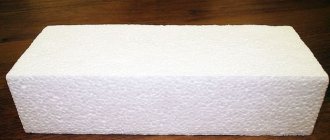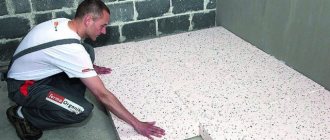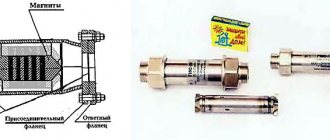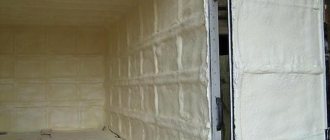Advantages and disadvantages of a garage
- suitable temperature;
- lack of direct sunlight;
- humidity (if the air is dry, as is often the case at home, the tubers will lose moisture and, accordingly, their taste).
If storage standards are not observed, the advantages can easily turn into disadvantages:
- as the temperature rises, the tubers will begin to germinate;
- when it falls below normal, they will freeze and become sweet;
- If there is too much moisture, the potatoes will rot.
Preventing mold and mildew in the basement and garage
You won’t need to think about how to get rid of mold in the garage basement if you take simple preventive measures:
- once a year treat the walls, floor and ceiling with lime mortar and copper sulfate;
- arrange a high-quality ventilation system. Natural ventilation is not always effective due to weather conditions, especially with high humidity; forced ventilation is needed;
- make reliable waterproofing of the floor and walls in the basement; if necessary, you need to install a central drainage system to drain groundwater;
- eliminate all dew points where condensation accumulates. Metal parts in the walls and ceiling must be insulated with mineral wool and cemented.
Deep penetration antiseptic primers for wood, metal and cement surfaces indoors are also effective in combating mold.
Storage in a garage without a cellar and with a cellar: what is the difference?
Fully recessed storage facilities are optimal for storing crops. After all, the temperature in the garage cellar is more constant throughout the year.
- No costs for the construction of additional structures.
- There is no direct sunlight, which means that the tubers will not produce solanine, a toxic substance chemically equal to steroids.
There are also disadvantages:
- Before placing potatoes in the cellar, they must be carefully sorted and dried.
- If your cellar is not equipped with a temperature sensor, then it will be impossible to adjust the temperature.
Preparation for work
At first, building a cellar with your own hands may seem like an extremely difficult task, but even a novice builder can cope with it. The most difficult step will be choosing a suitable location. Previously, it was believed that a cellar could only be located under a house or on a summer cottage. But in reality, it can be organized even in the garage. Therefore, apartment owners should not refuse to store their crops.
Before you start building a vegetable pit, you need to consider the following questions:
- Checking the availability of utilities. If you are going to build a cellar within the city, make sure that you will not touch electrical cables, pipelines and gas lines. In this regard, it is much better to make a hole in an already finished room - a garage or cellar.
- Soil study. Most often, you will need the help of a specialist to carry out this stage. It will help establish soil characteristics and groundwater levels. You cannot ignore these factors, as otherwise you risk getting a regularly flooded vegetable pit. Ideally, groundwater should lie well below the intended bottom of the storage facility, otherwise you will need a complex waterproofing system. This will entail large financial and time costs. Most professional builders believe that even waterproofing will not help - sooner or later water will still seep into the hole.
- Project development. Before starting construction, it is worth spending time calculating the area of the future storage facility and creating a drawing. This will reduce possible shortcomings and greatly simplify your work.
How to store
Here are the conditions that must exist here for wintering of potatoes to be possible:
- Ideally, you need to know where the groundwater flows - the bottom of the storage facility should be two meters away from it.
- The most favorable temperature for storing potatoes is from +2 to +4 degrees.
- Air humidity is no more than 85% percent.
- Lack of light.
There are several ways to organize the storage of tubers in the garage; let’s consider them in order. By the way, read our article on how to store potatoes in an apartment.
This is a popular option, which is a long mound of potatoes, which is fenced on the sides with boards. The following are laid out layer by layer on top:
- straw 60–80 cm;
- ground 45–70 cm;
- heat-insulating material.
For ventilation purposes, a vertical pipe is installed, and grooves are dug around to remove moisture. Such storage is considered temporary, and can be seen in naturally ventilated garages.
Cellar
To make it suitable for storing vegetables, the following should be taken into account when equipping it:
- if soil moisture is low, the walls are made of brick;
- if, on the contrary, it is high, preference is given to concrete walls with waterproofing;
- the floor consists of three layers: crushed stone, bitumen and concrete mixture;
- for moisture insulation, the walls are covered with lime;
- the ceiling is sloped towards the hood to prevent condensation from settling;
- lighting should be low voltage.
You can store potatoes directly in the garage basement in bags, boxes (wooden or plastic) or nets.
Boxes
They should not be “deaf”; a distance of 3 cm is maintained between the slats for ventilation. A gap of 20 cm is required from the floor of the room to the bottom of the box, and 30 cm from the wall to the box. This will ensure better ventilation. The distance between the boxes themselves is 10 cm.
Thermal box
Using the built-in thermostat, you can set and maintain the desired temperature regardless of weather conditions. You can purchase this design or make it yourself:
- Make two boxes of different sizes from wood.
- Place one inside the other, and put about 10 cm of thermal insulation between them.
- Lay strips of film heated floor on the bottom; they are synchronized with a thermostat, which is attached to the outer side of the box.
Nets or bags
Storage in nets is the simplest and most common option. Air circulates freely between the tubers, so the potatoes do not become moldy.
Equally often, tubers are stored in bags. Here, air also penetrates well inside, and in addition, the burlap itself performs a heat-protective function. The bags are placed on a wooden rack or on a pallet, lying down or in a circle, no more than five rows up (up to three meters). The top is covered with straw.
How to store tubers without a cellar in the country?
The dacha can be used as a place to store potato crops. It is advisable to choose the coldest places to place vegetables. It is usually cold at the front doors or in the entryway. Potatoes can be placed here using fabric bags to promote ventilation. It is worth noting that you can keep tubers in the coldest places at above-zero temperatures. Knowledgeable people put dry straw or beets on top of the bags. This is done to prevent the potatoes from getting soggy.
Potatoes can be transported to the city if the apartment building provides storage rooms or access pockets where the crop can be sent after placing it in wooden boxes. When the room is warm, potatoes last less time. You can solve this problem by taking a plastic container (for example, a bottle). You need to make a couple of dozen holes in it, place a damp cloth inside and put it in a box.
A glazed loggia in an apartment in winter will also help preserve the harvest. Warm old clothes or cotton blankets are placed on the bags so that temperature changes do not affect the tubers.
When there is no possibility of moving potatoes, it is worth using a non-standard, but very effective storage method:
- select a site on the territory that is not flooded with water;
- a hole is dug (depth - one and a half meters, volume depends on the potato harvest);
- the bottom is prepared (along its edges you need to make grooves 10 cm deep for drainage);
- the walls and bottom of the pit are lined with straw;
- tubers with the first frosts are placed in a “storage” (about 40 cm should remain to the top) and covered with straw;
- a hill (58-80 cm) is formed above the pit; it should protrude beyond the walls of the pit by 1 meter on all sides. When extreme cold sets in, it is worth taking care of additional thermal insulation (straw or snow).
Typically, this method is used to store planting material. You can also use another option for a “mini-cellar” for your dacha:
Mozilla/5.0 (X11; CrOS i686 1660.57.0) AppleWebKit/535.19 (KHTML, like Gecko) Chrome/18.0.1025.46 Safari/535.19 [81.177.174.224]
The dacha can be used as a place to store potato crops. It is advisable to choose the coldest places to place vegetables. It is usually cold at the front doors or in the entryway. Potatoes can be placed here using fabric bags to promote ventilation. It is worth noting that you can keep tubers in the coldest places at above-zero temperatures. Knowledgeable people put dry straw or beets on top of the bags. This is done to prevent the potatoes from getting soggy.
Cellar storage
It is important that the cellar is clean and that by the time tubers are loaded into it the temperature in it should not be higher than at least 7–8 o C. Cleanliness means not only basic cleaning, but also periodic whitewashing of the walls, ceiling and shelves with lime and fumigation of the room with sulfur saber. The floor in the cellar is often covered with clean sand. You can store potatoes in the cellar either in bulk or in any non-airtight containers.
It is important that there is the possibility of periodic ventilation of the cellar, and ideally, the presence of a constant hood. If the humidity is high, jars or buckets of quicklime are placed in the room; if it is low, the ceiling and walls are sprayed with water. The light should only be turned on for a short time.
The cellar must be in perfect order
How to choose a place
Usually they try to place the potatoes right in the kitchen, although this is not an ideal option. The coldest place is usually near the doors (including the balcony), but even there the temperature is rarely below 15–16 o C, so we will talk about a month at most. Sometimes cool storage rooms are used, if available. In the kitchen, potatoes are usually placed under the sink in a wooden box or basket. As a rule, this place is closed from light and properly ventilated. Since storing potatoes in an apartment is difficult, some tricks often come to the rescue, the simplest of which is lining them with mint or wormwood leaves. It’s good if there are beets nearby (in fact, the same techniques are used outside the apartment).
Small quantities of potatoes are stored under the sink
Cellar in the garage: what can you store?
If the cellar is made correctly: using heat and waterproofing materials, with forced or natural ventilation installed in it, with the construction of special shelves for storing food, then it can be stored in good condition until the end of spring as canned goods in jars and other containers and fresh vegetables: carrots, potatoes, beets, cabbage, etc.
In this case, not only the conditions created in the room are taken into account, but also the requirements for food storage . The lids should tightly close the jars, the potatoes should be placed in boxes with holes (if they are dry, they rot less), apples and large ranetkas should be wrapped in parchment paper, etc.
What does a cellar look like in a garage - photo:
Advantages
It makes sense to build a basement if the garage space is owned and expected to be used for many years. What are the advantages of a cellar in the garage?
- It is under lock and key. To get supplies for the winter, you first need to get into the garage. Therefore, “raids” of dubious individuals are excluded.
- The vegetable pit is located directly under the garage in a warm zone , so the cost of thermal insulation is minimal.
- Winter preparations and vegetables are close , just a stone's throw away. There is no need to go somewhere far to your summer cottage or dig out snowdrifts to provide access to the basement.
- The entrance to the cellar can be made directly from the inspection hole. Thus, 2 problems are solved: the workpieces are in the right place, and you can easily repair the car.
- With its compact size, such a room can become a storage facility for a large number of products .
- Since there is no need for a room for storing food supplies, the cellar can be easily converted into a workshop or storage room for things .
See the photo below for an example of a vegetable pit in the garage :
in excellent condition until late spring . But it is worth paying special attention to ventilation . Natural, usually consisting of 2 pipes, one of which is installed above the floor level, and the second above the ceiling, does not always save the situation. It would be better if these were modular systems controlled by a mini-computer. Then the conditions in the basement can be controlled artificially .
Basic Rules
Each variety of vegetable requires specific storage conditions, but regardless of this, there are basic rules:
- Only healthy specimens are suitable, without signs of infection, insect damage or external chips.
- Before storing vegetables in the basement or other appropriate place, they must be sorted and substandard items removed - rotten, cut and diseased specimens. Overripe and underripe vegetables are discarded.
- Only late and mid-late varieties of vegetables (onions, beets, cabbage and carrots) are stored for long-term storage.
- The harvest is thoroughly dried beforehand.
- Store in ventilated containers.
- Select a dry room.
- In damp basements, it is recommended to place sawdust or ash to absorb excess moisture.
During the winter, the products are sorted out several times and spoiled specimens are thrown away.
The main vegetable harvest occurs in late August or early autumn. Root vegetables (potatoes, beets, carrots, onions) are carefully dug up with a shovel so as not to touch them. They are carefully cleaned of adhering dirt by hand, washed under running water, and dried in the fresh air under a canopy or in a ventilated area. Unless absolutely necessary, you don't have to pre-wash. It is recommended to harvest cabbage later, when the weather is cool outside.
What is it intended for and what characteristics should it have?
Fruit and vegetable products purchased or grown by yourself must be stored somewhere in the winter. Refrigerators are used to store winter preparations and fresh vegetables in small quantities. However, the refrigerator will not fit a bag of potatoes and several boxes of garlic and onions. Therefore, you have to independently build a special room where you can place the twists with vegetables. The microclimate in such cellars allows you to keep the crop fresh for 4-5 months.
Sizing
Before equipping your garage space with a vegetable pit, you need to decide on its size.
When determining the area of the cellar, the thickness of the base and walls is taken into account. Also, when calculating the optimal area, it is taken into account that the size of the room for storing vegetables should be comfortable for the person inside. Therefore, experts advise digging a pit, the width of which will be 70-80 centimeters.
This is enough for a person to move around the cellar without problems. However, in large garages that are designed for trucks, the pit can be made larger.
Since the pit should be located under the garage, its length directly depends on the length of the garage space, as well as on the number of products that will be stored in it. For example, if a cellar is built for a small amount of pickling, then its length can be 2-3 meters.
The minimum depth of the cellar for storing pickles is one and a half meters. However, if the owner of the premises is too tall, they dig a pit 160-170 centimeters deep.
Advantages of a cellar located under the house
The most popular thing among gardeners living in a private house is to build a cellar in the underground. This is due to a number of reasons:
- All the necessary products and jars with twists are always at hand.
- A cellar previously thought out during the construction of a house will simplify the construction of the storage facility itself: there is no need to dig an additional pit.
- Thanks to an insulated basement, the floors in the house will be much warmer.
- Ease of lighting in vegetable storage.
In addition, some make the cellar a full-fledged room and an extension of the house; they place not only vegetables, fruits and winter preparations there. High-quality finished walls and the creation of a specific interior will allow you to turn it into a separate room for tasting homemade wines. The unique design of basements helps to create real masterpieces, photos of which are posted on our website in thematic sections.
In this video we will look at arranging a cellar in a garage:
This is interesting: how to prepare a cellar for storing vegetables.
Advice! Before starting construction of a house and cellar, the groundwater level must be determined. Subsequent calculations for digging a pit are based on these indicators.
Necessary tools and materials for arrangement
Before arranging the cellar under the garage, prepare the necessary materials and tools.
Among the tools that will be used during construction work are the following:
- Bayonet shovel. Used to dig a pit in which the cellar will be built.
- Shovel Used to clean a dug pit from excess soil.
- Hacksaw. An indispensable tool used for sawing wood beams from which the basement walls will be sheathed during insulation.
- Fastening components. To fasten wooden and metal structural elements, nails and screws are used.
You will also need the following materials:
- bricks for creating walls;
- cement mortar;
- insulating materials that will protect the cellar from freezing;
- iron corners;
- wooden beams.
Construction stages
Digging a hole for storing vegetables is not too difficult. It is much more difficult to equip it correctly. When building a vegetable storage facility, it is necessary to take into account the issues of arranging the floor and walls, organizing hydro- and thermal insulation, as well as ensuring ventilation.
If you are installing a hole in an open area, and not in a finished basement or garage, first dig a pit of the required size.
Arrangement of floors, walls and ceilings
10 cm of crushed stone and 15 cm of sand are placed at the bottom of the pit. Each layer must be compacted thoroughly. After preparation, the layers must be filled with bitumen or another substance with similar properties. Ideally, pour a slab of reinforced concrete, first laying a layer of waterproofing material. If this option is not possible, you can cover the floor with wooden boards.
Then you need to tackle the walls and ceiling. Alternatively, you can lay the walls out of brick. In this case, it is better to lay out the ceiling of the pit with a vault, laying bricks on templates made of boards. You can also make a concrete floor. To do this, you need to prepare wooden formwork and lay the reinforcement frame inside.
When working with the ceiling, you need to leave room for a crawl space. It is best to make it in the middle of the ceiling. In this case, you will have enough space to place shelving. A stop for the lid should be installed in place of the hole.
When the ceiling is ready, it is necessary to insulate it. To do this, coat it with bitumen and insulate it using the existing insulating material (foam, expanded clay or slag).
Waterproofing
High-quality waterproofing is a prerequisite for long-term storage of crops. This issue should be taken especially seriously if the groundwater level in the area is high enough. In this case, you will have to build a circular drainage system.
Thermal insulation
Natural vegetable products do not tolerate sudden temperature changes. Sudden warming can lead to rot and disease, and frost will cause severe flavor changes. For this reason, you must ensure that your storage unit is maintained at a suitable temperature at all times. This is easiest to do with proper thermal insulation.
It is better to insulate the walls on both sides - external and internal. But often the vegetable pit goes to the owner of an already built one, so its external insulation is impossible. Then all that remains is to insulate its internal walls. This work can be done with your own hands using any slab insulation. Don't forget to make sure it is moisture resistant. Experts believe that polystyrene foam will be the best choice.
Providing ventilation
Constant air circulation will help maintain the correct microclimate in the storage. Therefore, the final stage of construction should be the organization of a balanced ventilation system.
An option for installing ventilation in a vegetable pit located in the garage.
The simplest option that you can build with your own hands is natural ventilation using two pipes. One of them will be a supply, and the other an exhaust. They need to be placed at different heights in opposite corners of the cellar. You can use any pipes that you have, but for a vegetable pit, plastic or asbestos-cement pipes with a diameter of 10-15 cm are better suited. The supply pipe should start 20 cm from the floor and go out at a height of about 20 cm above the level of the cellar lid. The exhaust system should start right at the ceiling and extend as high as possible above the roof of the room.
Valves should be installed on the pipes to regulate the air flow. To protect the storage from pests, the end of the supply air duct is covered with a fine metal mesh. To protect against precipitation, the upper end of the exhaust pipe is placed under a special umbrella cap.
The difference in temperature and pressure will ensure a constant flow of fresh air into the room.
Separately, it should be said about the need for high-quality ventilation of the pit located in the garage. Exhaust gases from the vehicle must be removed in a timely manner and not reach food products.
How to design a vegetable pit in the garage with your own hands
To build a vegetable pit correctly, you will have to understand the main stages of construction.
We build a hole
The cellar begins to be created by digging a pit in which a basement will be built for storing vegetables and preserves. After this, the floor is arranged. To make the floor covering reliable, it is made of several layers. First, the bottom is covered with a small layer of crushed stone, which is compacted with a vibrating plate. Then the compacted crushed stone is covered with construction sand and filled with concrete.
When the flooring has hardened, the walls are finished. A solid brick that is resistant to high humidity is suitable for this. The walls are laid out in such a way that the seams of each subsequent row of bricks do not coincide with the previous one.
After creating the walls, a reliable ceiling is created that can withstand any load. When making a ceiling, boards are laid at the top of the pit, on which reinforcement is laid and concrete is poured. Having finished with the ceiling, you can make a staircase, which is installed near the entrance inside.
Drainage
Before using the vegetable pit, dry the room so that the walls, ceiling and floor are completely dry. There are several methods that help dry out the cellar:
- Place a metal bucket in the center of the basement, fill it with firewood and build a fire. When using this method, you will have to maintain the fire for an hour and a half.
- Place a metal pipe outside and place a burning candle underneath it, which will provide natural draft.
Waterproofing
Sometimes vegetable pits are made in areas with high groundwater levels, which increase humidity. In this case, you need to install waterproofing inside the basement, which will help keep the humidity level within normal limits.
Experienced builders advise taking care of waterproofing at the stage of creating walls and floors. To protect against high humidity, special waterproofing compounds are added to the concrete mixture, which close all cavities in the concrete.
Choice of insulation
To maintain the optimal temperature inside the cellar, additional thermal insulation will be needed. The selected thermal insulation material must have the following properties:
- environmental friendliness;
- chemical safety;
- reliability;
- protection from moisture.
To insulate storage for vegetables, use polystyrene foam or polystyrene foam.
Ventilation opening design
Any cellar must have ventilation, since it is responsible for the circulation of oxygen inside. When organizing a ventilation system, they install supply and exhaust pipes. The supply air is located near the floor, and the exhaust is led out through the roof.
Choose
The place for arranging a vegetable moat should be located on a hill, which in the future will protect it from turning into a swimming pool during spring snowmelt or autumn rains.
Before starting construction, you should find out in advance the depth of groundwater by looking into the nearest well. (Read here how to find water on your property.)
We are building
To begin with, a pit is dug about 2.2 meters, about two meters wide. A “cushion” of sand and crushed stone is placed at the bottom, and bitumen is poured on top. A concrete slab is suitable for the flooring; in extreme cases, you can use hardwood boards.
Even if the owner is lucky and the soil is dry and dense, the walls of the pit will sooner or later begin to crumble . So you will have to spend money on brick walls that you can lay out yourself. To protect against moisture, it is desirable to treat the walls of vegetable storage with bitumen; sometimes they are additionally sheathed with clapboard.
We insulate
In regions with mild climates, you can do without additional insulation.
Here are some tips for residents of harsher climes.
A suitable insulation should:
- are not afraid of water,
- be non-toxic,
- do not emit strong odors,
- do not lose thermal insulation properties for a long time,
- have a minimum thickness.
fits all these parameters . It is sprayed onto the walls and ceiling, and after hardening it turns into a monolithic layer of sealant with good insulating properties. There is only one minus - it is not a cheap pleasure, and therefore less convenient polystyrene foam . It is better to apply insulation to a prepared and plastered surface.
Ventilate
without ventilation in a pit for storing vegetables. One of the pipes (preferably plastic) is embedded in the wall at a height of 20 cm from the floor, the second - on the opposite wall under the ceiling. The ends of the pipes from the outside should be raised as high as possible. The air flow resulting from the difference in temperature and pressure prevents the appearance of dampness and allows food to be stored longer.
SOS! We're drowning!
High groundwater levels can cause a lot of trouble for owners. The only way to quickly dry a cellar is with a heat gun. A slower method: an old bucket, in which the fire is maintained until the room dries out. And, of course, before this you need to pump out or bail out the water.
Radical Savings
Such a depression in the ground is one of those small architectural forms on the construction of which you can save a lot . It can be built from a pile of rubbish that is lying around in the backyard of almost any household.
is installed at the corners of the pit . A metal corner is best suited for this; a frame around the perimeter is also made from it. Pipes made of the same material are also suitable. A fine mesh fishnet is attached to the frame. It will hold the earthen walls.
Our vegetable cellar is covered with an iron sheet or boards, polystyrene foam is placed on top (for insulation) and covered with earth.
Disadvantages of such a structure:
- suitable only for regions with warm climates;
- In winter, frost forms on the ceiling, during a thaw it turns into water and drips down onto the vegetables;
- the soil may sag and frost gets inside;
- metal rusts.
Pit in the garage
It would be a good idea to provide for the possibility of storing food in the garage when constructing the building itself. But since you didn’t think of it then... You should balance your appetites with the size of the garage: you shouldn’t dig under the foundation, the walls will crack from greed.
You should go deeper into the soil carefully and slowly: you can find a lot of interesting things there, like a gas pipeline or an electric cable.
The vegetable pit in the garage is dug and strengthened according to the recommendations outlined above.
A vegetable pit is the most practical way to store crops for a long time. Such a pit or cellar is a special place for storing food, which can be arranged in a summer cottage, in the basement of a residential building, in a garage or even under a loggia. Its main advantage is the complete absence of energy costs - the freshness of your vegetables and fruits will be maintained naturally. From the article you will learn how to build a vegetable storage facility with your own hands and how to use its space most efficiently.










